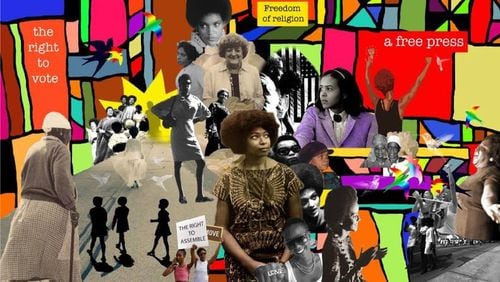Aside from Rosa Parks, most of the commonly remembered civil rights leaders and figures tend to be male — the Rev. Martin Luther King Jr., John Lewis and Ralph David Abernathy, just to name a few.
The City of Atlanta's Office of Cultural Affairs has decided that it's time women of the civil rights movement received more attention. To accomplish this, a public art dedication titled "Journey to Freedom: Women of the Civil Rights Movement" will debut from 2 to 4 p.m. Saturday. It is at the Freedom Trail at the Atlanta Beltline Crossing. Entry is free.
The dedication features two murals and incorporates figurative silhouettes of both past and current female civil rights figures. Photography from the civil rights movement taken by Doris A. Derby, Susan Ross and Sheila Turner is also included.
“A lot of times, it takes many years for people to realize that this particular aspect of a movement is very, very crucial,” said Derby, a documentary photographer. “It takes a long time to uncover those things that are going on.”
Capturing the times on film
Derby’s photos mostly capture the late 1950s through the 1970s era of civil rights since she lived through and documented it, taking thousands of photos during the era.
Derby worked in Mississippi as a civil rights worker for the Student Nonviolent Coordinating Committee(SNCC), and this is how she met many of the people she ended up photographing.
“It wasn’t that I was going in and taking pictures and … leaving,” Derby said. “They were people that I worked with or with projects that I worked with.”
This led her to meet many pivotal female figures such as Dorothy Height, Nikki Giovanni, the Harambee Singers and Jean Childs Young, all of which are featured in the art dedication. She has 20 photos in total featured on the two murals.
“Many of the stories behind the lives of the women and their works have never been told,” Derby said.
Three of the photos feature students protesting at Jackson State University in 1970 after two black men were killed in a police shooting. She said this draws obvious parallels to the current #BlackLivesMatter movement.
“We’re still dealing with many of the same issues,” Derby said. “History serves as an education tool and inspiration tool for people to be able to chart their lives in the present and be inspirational.”
Witnessing and participating in history
One of the most influential people she met and photographed was Constance Curry. They met because they were both involved in SNCC. A photo of Curry is featured on the murals.
Curry, who is of Irish descent, grew up in New Jersey until moving to North Carolina when she was 4 years old. From there, she said she witnessed racism, and it confused her and her parents.
“My parents didn’t understand, being from Ireland, the racial stuff that was going on,” Curry said. “I remember my mother saying, ‘Why do the black people have to come through the back door?’”
In 1960, she led a National Student Association program to host integrated meetings between black and white students in Atlanta. While on a drive from Greensboro, N.C., to Atlanta to kick-start the program, she heard something peculiar on the radio, unaware of the history that was unfolding before her.
"I was on my way to Atlanta, and I had the radio on and it said, 'Four students from A&T College (North Carolina A&T State University) are seated at Woolworth's in downtown Greensboro," Curry said. "And I thought, 'What in the world?' I've never heard of that before."
This event is now known as the first Greensboro sit-in, a protest movement to get the Woolworth's chain to remove its racial segregation policy. These sit-ins then rapidly grew around the South, helping accomplish what Curry was setting out to do.
Curry would go on to be the director of the Office of Human Services in Atlanta from 1975 to 1990.
“Fulton County, by law, was in charge of human services, but they catered mostly to county and white people rather than a city mostly black,” Curry said, referring to the job she was stepping into back in 1975.
Creating and preserving
The stories Derby captured are only a few that will be preserved in the two murals, both of which were designed and installed by Lynn Linnemeier as well as the rest of the dedication.
“It was difficult working with other people’s images, but right from the beginning, I knew what I sort of wanted to do,” Linnemeier said.
She said the biggest challenge she faced was getting photographs onto the two mural walls in a way that looked natural and would last a long time without deteriorating.
“They knew they wanted photographs on those walls,” Linnemeier said. “The question became, how do I do that? How do you get photographs on a wall that would last?”
She ended up using a technique used by anonymous French photographer JR, who is known for flying large photographic images in public places.
“So I went online and Googled, ‘How does JR make these giant photographs?’ or something like that,” Linnemeier said.
This ended up getting her in contact with Davidson & Co., based out of Marietta, which helped her accomplish the mural creation in Adobe Photoshop using separate layers. It took her roughly two months to complete the design.
One of the murals revolves around the themes of kindness, love and respect, while the other one focuses on civil liberties such as the First Amendment, voting rights and the pillars of democracy.
“Many people will be inspired, and I think there can be murals like this in other places,” Derby said.
EVENT PREVIEW
“Journey to Freedom: Women of the Civil Rights Movement”
2-4 p.m. Feb. 25. Free. Freedom Trail at the Atlanta Beltline Crossing. 299 Alaska Ave. N.E., Atlanta. 404-546-6815, ocaatlanta.com.
About the Author



